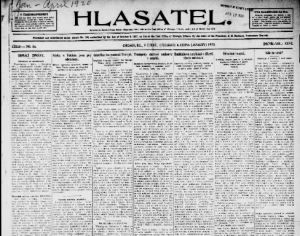In August 2016 HPNL and Preservation Services received a fourth round of grant funding for the National Digital Newspaper Program (NDNP), a project supported by the National Endowment for the Humanities (NEH) and the Library of Congress. The grant supports the funding for the digitization of 100,000 pages of newspapers. For this cycle UIUC focused on immigrant Chicagoland-based newspapers from the late 19th century and early 20th century. As part of this project, I was tasked with producing short essays summarizing the history of two related Czech-American newspapers: Denní hlasatel (Daily Herald) and its weekly counterpart, Týdenní hlasatel (Weekly Herald). The essays were to appear in the Library of Congress powered site, Chronicling America, as well as UIUC’s newspaper portal, the Illinois Digital Newspaper Collections (IDNC).
It all started in 1891 when the Czech Typographic Union of Chicago went on strike. The typesetter’s union, which was founded on December 7th, 1890, demanded shorter working hours and increased wages. Their demands were rejected, resulting in a strike and no staff to print newspapers for two days. Responding to this lack, the union started their own daily newspaper– Denní hlasatel – which quickly gained popularity after its May 4th, 1891 release date. In fact, its subscribers grew to a greater number than those of well-established newspapers such as Chicažských Listů (The Chicagoan Newspaper). At the end of its publication in 1994, it was the oldest Czechoslovak daily in the world and one of the most significant compatriot newspapers of the pre-war period.

The nature of its inception played a large role in the paper’s mission throughout its lifetime. Both the daily and the weekly were were directed by union members and their content was dedicated to the interests of Czech-American workers. In 1901, the paper writes, “Our paper is union. All work on it is done by union labor.” The papers kept their readers up-to-date on local and national labor news, and regularly printed editorials in solidarity with other Chicago unions. In 1902, the paper published an editorial in support of striking coal miners in California. The editorial reads, “Bohemians, without exception, sympathize with the locked-out coal miners and, with all their heart, wish for them a victory over the pot-bellied capitalists. In order to help the coal-miners to gain their victory Bohemians will contribute their dollars.” The paper also participated in the debates of significant strikes, such as the Chicago Garment Workers’ Strike of 1910, detailing the involvement and contribution of Bohemian workers.
As I researched the union-born publications, memories of the not-so-distant Graduate Employee Organization strike were palpable. On February 26th, 2018, the Graduate Employees of UIUC went on strike after many months with no contract. You might remember the main quad filled with yellow-beanie-clad Teaching Assistants, Graduate Assistants, and their allies (professors, non-tenured faculty, undergraduates, community members) banging on drums and chanting in solidarity, as they demanded a protections for tuition waivers, fair wages, accessible health care, protections for international graduate employees, and benefits for student parents. A total of 12 days, it was the longest strike in UIUC history.

Furthermore, in the national spotlight is the Supreme Court’s June 2018 Janus v. AFSCME ruling, which bars public sector unions from charging “agency fees.” As a result, unions will have to lobby public employees to pay union dues, although all employees (paying or nonpaying) will receive all the same benefits of the union. It is a ruling that many feel will weaken American unions, negatively affecting those in unionized professions. It is a fact that unionized employees earn better wages and benefits, such as health insurance and retirement benefits. For people of color and women, the impact of a union is even greater.
What can a Czech-American newspaper teach us about these contemporary events? Although these events are over a century apart, they speak to each other, they tell a story of our history, as Illinois residents and as Americans. Local and national responses to employees, their labor, and their unionizing efforts can highlight systemic challenges in a capitalist apparatus. Comparative study of unions and labor movements across centuries can illustrate how these issues are collectively solved and the trajectory of their resolutions. By making publications such as Denní hlasatel accessible with digitation, translation of a lesser-known language (Czech), and analysis, we open the door to learning not only of events past, but to understanding their impact and discovering what they can teach us about today.
Sources:
Habenicht, Jan. Dejiny Chechuv amerických (St. Louis, Mo.: Tiskem a nákladem casopisu “Hlas,” 1904)
Jaklová, Alena. Čechoamerická periodika 19. a 20. století (Prague: Academia, 2010)
Nadia Hoppe is a doctoral candidate in the Department of Slavic Languages and Literatures.